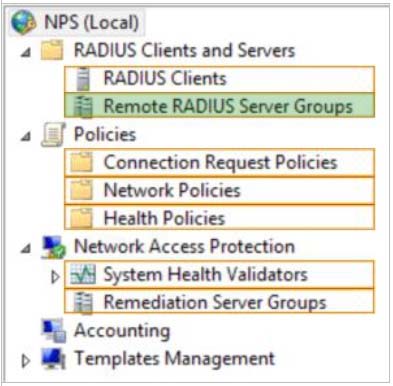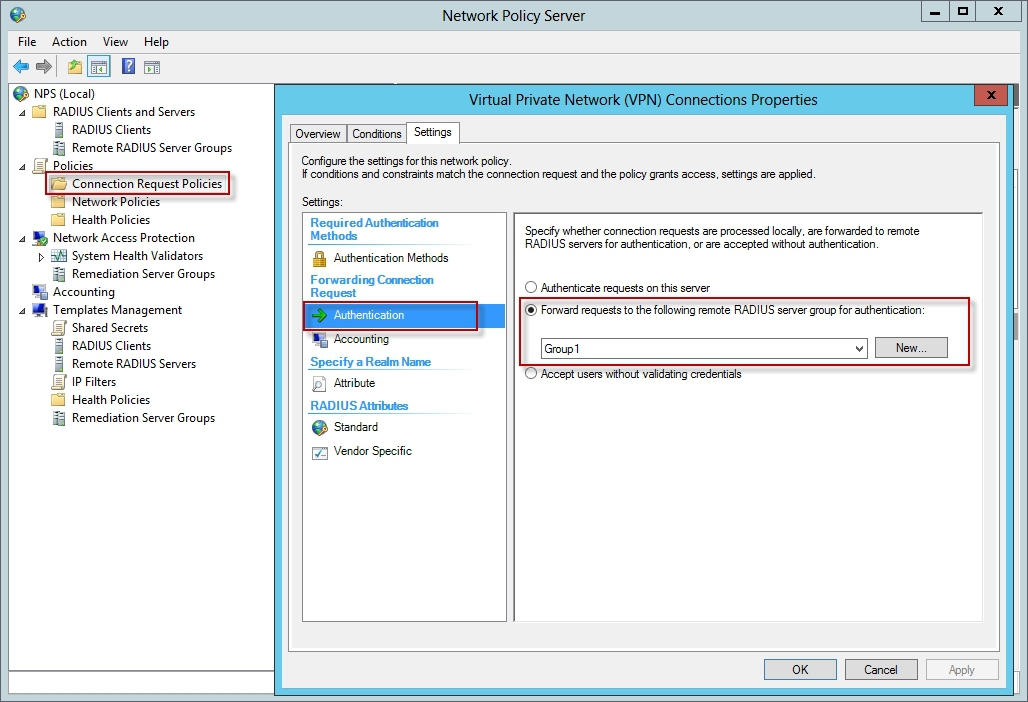Microsoft 70-411 Exam Practice Questions (P. 2)
- Full Access (300 questions)
- Six months of Premium Access
- Access to one million comments
- Seamless ChatGPT Integration
- Ability to download PDF files
- Anki Flashcard files for revision
- No Captcha & No AdSense
- Advanced Exam Configuration
Question #6
HOTSPOT -
Your network contains a RADIUS server named Server1.
You install a new server named Server2 that runs Windows Server 2012 R2 and has Network Policy Server (NPS) installed.
You need to ensure that all accounting requests for Server2 are forwarded to Server1.
On Server2, you configure a Connection Request Policy.
What else should you configure on Server2? To answer, select the appropriate node in the answer area.
Hot Area:
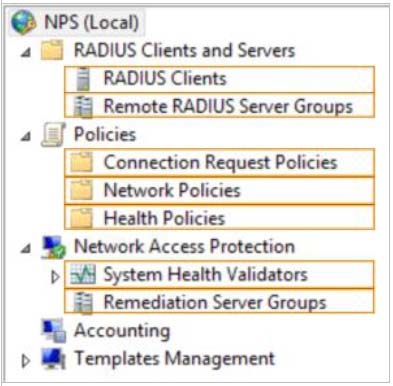
Your network contains a RADIUS server named Server1.
You install a new server named Server2 that runs Windows Server 2012 R2 and has Network Policy Server (NPS) installed.
You need to ensure that all accounting requests for Server2 are forwarded to Server1.
On Server2, you configure a Connection Request Policy.
What else should you configure on Server2? To answer, select the appropriate node in the answer area.
Hot Area:

send
light_mode
delete
Question #7
Your network contains an Active Directory domain named contoso.com. The domain contains a server named Server1 that runs Windows Server 2012 R2 and has the Network Policy Server role service installed.
An administrator creates a RADIUS client template named Template1.
You create a RADIUS client named Client1 by using Template 1.
You need to modify the shared secret for Client1.
What should you do first?
An administrator creates a RADIUS client template named Template1.
You create a RADIUS client named Client1 by using Template 1.
You need to modify the shared secret for Client1.
What should you do first?
- AConfigure the Advanced settings of Template1.
- BSet the Shared secret setting of Template1 to Manual.
- CClear Enable this RADIUS client for Client1.
- DClear Select an existing template for Client1.
Correct Answer:
D
Clear checkmark for Select an existing template in the new client wizard.
In New RADIUS Client, in Shared secret, do one of the following:
Bullet Ensure that Manual is selected, and then in Shared secret, type the strong password that is also entered on the RADIUS client. Retype the shared secret in
Confirm shared secret.
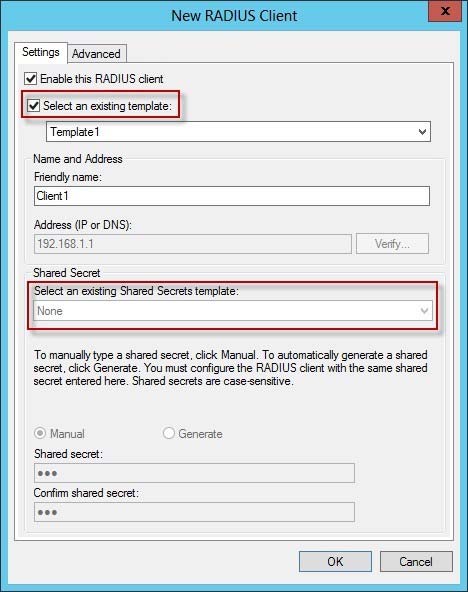
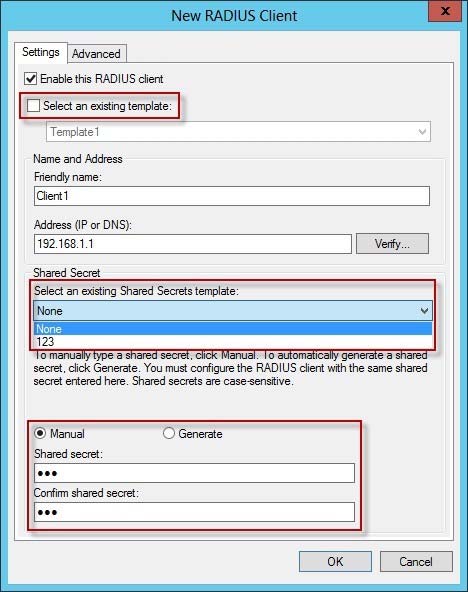
D
Clear checkmark for Select an existing template in the new client wizard.
In New RADIUS Client, in Shared secret, do one of the following:
Bullet Ensure that Manual is selected, and then in Shared secret, type the strong password that is also entered on the RADIUS client. Retype the shared secret in
Confirm shared secret.


send
light_mode
delete
Question #8
Your network contains an Active Directory domain named contoso.com. All servers run Windows Server 2012 R2.
The domain contains a server named Server1 that has the Network Policy Server server role and the Remote Access server role installed. The domain contains a server named Server2 that is configured as a RADIUS server.
Server1 provides VPN access to external users.
You need to ensure that all of the VPN connections to Server1 are logged to the RADIUS server on Server2.
What should you run?
The domain contains a server named Server1 that has the Network Policy Server server role and the Remote Access server role installed. The domain contains a server named Server2 that is configured as a RADIUS server.
Server1 provides VPN access to external users.
You need to ensure that all of the VPN connections to Server1 are logged to the RADIUS server on Server2.
What should you run?
- AAdd-RemoteAccessRadius -ServerNameServer1 -AccountingOnOffMsg Enabled -SharedSecret "Secret" -Purpose Accounting
- BSet-RemoteAccessAccounting -AccountingOnOffMsg Enabled -AccountingOnOffMsg Enabled
- CAdd-RemoteAccessRadius -ServerName Server2 -AccountingOnOffMsg Enabled -SharedSecret "Secret" -Purpose Accounting
- DSet-RemoteAccessAccounting -EnableAccountingType Inbox -AccountingOnOffMsg Enabled
Correct Answer:
C
Add-RemoteAccessRadius -
Adds a new external RADIUS server for VPN authentication, accounting for DirectAccess (DA) and VPN, or one-time password (OTP) authentication for DA.
AccountingOnOffMsg<String>
Indicates the enabled state for sending of accounting on or off messages. The acceptable values for this parameter are:
✑ Enabled.
✑ Disabled. This is the default value.
This parameter is applicable only when the RADIUS server is being added for Remote Access accounting.
C
Add-RemoteAccessRadius -
Adds a new external RADIUS server for VPN authentication, accounting for DirectAccess (DA) and VPN, or one-time password (OTP) authentication for DA.
AccountingOnOffMsg<String>
Indicates the enabled state for sending of accounting on or off messages. The acceptable values for this parameter are:
✑ Enabled.
✑ Disabled. This is the default value.
This parameter is applicable only when the RADIUS server is being added for Remote Access accounting.
send
light_mode
delete
Question #9
Your network contains four Network Policy Server (NPS) servers named Server1, Server2, Servers, and Server4.
Server1 is configured as a RADIUS proxy that forwards connection requests to a remote RADIUS server group named Group1.
You need to ensure that Server2 and Server3 receive connection requests. Server4 must only receive connection requests if both Server2 and Server3 are unavailable.
How should you configure Group1?
Server1 is configured as a RADIUS proxy that forwards connection requests to a remote RADIUS server group named Group1.
You need to ensure that Server2 and Server3 receive connection requests. Server4 must only receive connection requests if both Server2 and Server3 are unavailable.
How should you configure Group1?
- AChange the Weight of Server4 to 10.
- BChange the Weight of Server2 and Server3 to 10.
- CChange the Priority of Server2 and Server3 to 10.
- DChange the Priority of Server4 to 10.
Correct Answer:
D
During the NPS proxy configuration process, you can create remote RADIUS server groups and then add RADIUS servers to each group. To configure load balancing, you must have more than one RADIUS server per remote RADIUS server group. While adding group members, or after creating a RADIUS server as a group member, you can access the Add RADIUS server dialog box to configure the following items on the Load Balancing tab:
Priority. Priority specifies the order of importance of the RADIUS server to the NPS proxy server. Priority level must be assigned a value that is an integer, such as
1, 2, or 3. The lower the number, the higher priority the NPS proxy gives to the RADIUS server. For example, if the RADIUS server is assigned the highest priority of 1, the NPS proxy sends connection requests to the RADIUS server first; if servers with priority 1 are not available, NPS then sends connection requests to
RADIUS servers with priority 2, and so on. You can assign the same priority to multiple RADIUS servers, and then use the Weight setting to load balance between them.
Weight. NPS uses this Weight setting to determine how many connection requests to send to each group member when the group members have the same priority level. Weight setting must be assigned a value between 1 and 100, and the value represents a percentage of 100 percent. For example, if the remote
RADIUS server group contains two members that both have a priority level of 1 and a weight rating of 50, the NPS proxy forwards 50 percent of the connection requests to each RADIUS server.
. If NPS determines that a
RADIUS server is unavailable, it can start sending connection requests to other group members. With these settings you can configure the number of seconds that the NPS proxy waits for a response from the RADIUS server before it considers the request dropped; the maximum number of dropped requests before the NPS proxy identifies the RADIUS server as unavailable; and the number of seconds that can elapse between requests before the NPS proxy identifies the RADIUS server as unavailable.
The default priority is 1 and can be changed from 1 to 65535. So changing server 2 and 3 to priority 10 is not the way to go.
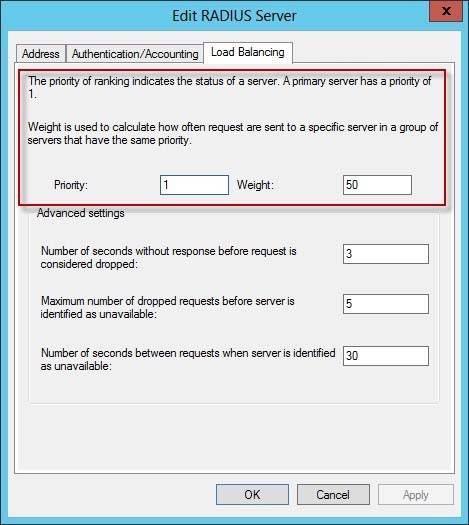
Reference: http://technet.microsoft.com/en-us/library/dd197433(WS.10).aspx
D
During the NPS proxy configuration process, you can create remote RADIUS server groups and then add RADIUS servers to each group. To configure load balancing, you must have more than one RADIUS server per remote RADIUS server group. While adding group members, or after creating a RADIUS server as a group member, you can access the Add RADIUS server dialog box to configure the following items on the Load Balancing tab:
Priority. Priority specifies the order of importance of the RADIUS server to the NPS proxy server. Priority level must be assigned a value that is an integer, such as
1, 2, or 3. The lower the number, the higher priority the NPS proxy gives to the RADIUS server. For example, if the RADIUS server is assigned the highest priority of 1, the NPS proxy sends connection requests to the RADIUS server first; if servers with priority 1 are not available, NPS then sends connection requests to
RADIUS servers with priority 2, and so on. You can assign the same priority to multiple RADIUS servers, and then use the Weight setting to load balance between them.
Weight. NPS uses this Weight setting to determine how many connection requests to send to each group member when the group members have the same priority level. Weight setting must be assigned a value between 1 and 100, and the value represents a percentage of 100 percent. For example, if the remote
RADIUS server group contains two members that both have a priority level of 1 and a weight rating of 50, the NPS proxy forwards 50 percent of the connection requests to each RADIUS server.
. If NPS determines that a
RADIUS server is unavailable, it can start sending connection requests to other group members. With these settings you can configure the number of seconds that the NPS proxy waits for a response from the RADIUS server before it considers the request dropped; the maximum number of dropped requests before the NPS proxy identifies the RADIUS server as unavailable; and the number of seconds that can elapse between requests before the NPS proxy identifies the RADIUS server as unavailable.
The default priority is 1 and can be changed from 1 to 65535. So changing server 2 and 3 to priority 10 is not the way to go.

Reference: http://technet.microsoft.com/en-us/library/dd197433(WS.10).aspx
send
light_mode
delete
Question #10
DRAG DROP -
Your network contains an Active Directory domain named contoso.com. All domain controllers run Windows Server 2012 R2.
The domain contains an organizational unit (OU) named OU1. OU1 contains an OU named OU2. OU2 contains a user named user1.
User1 is the member of a group named Group1. Group1 is in the Users container.
You create five Group Policy objects (GPO). The GPOs are configured as shown in the following table.

The Authenticated Users group is assigned the default permissions to all of the GPOs.
There are no site-level GPOs.
You need to identify which three GPOs will be applied to User1 and in which order the GPOs will be applied to User1.
Which three GPOs should you identify in sequence? To answer, move the appropriate three GPOs from the list of GPOs to the answer area and arrange them in the correct order.
Select and Place:
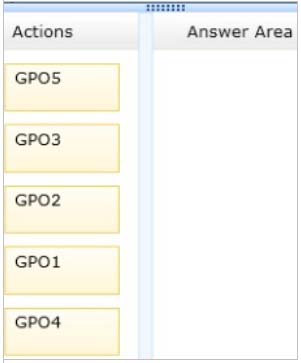
Your network contains an Active Directory domain named contoso.com. All domain controllers run Windows Server 2012 R2.
The domain contains an organizational unit (OU) named OU1. OU1 contains an OU named OU2. OU2 contains a user named user1.
User1 is the member of a group named Group1. Group1 is in the Users container.
You create five Group Policy objects (GPO). The GPOs are configured as shown in the following table.

The Authenticated Users group is assigned the default permissions to all of the GPOs.
There are no site-level GPOs.
You need to identify which three GPOs will be applied to User1 and in which order the GPOs will be applied to User1.
Which three GPOs should you identify in sequence? To answer, move the appropriate three GPOs from the list of GPOs to the answer area and arrange them in the correct order.
Select and Place:

Correct Answer:
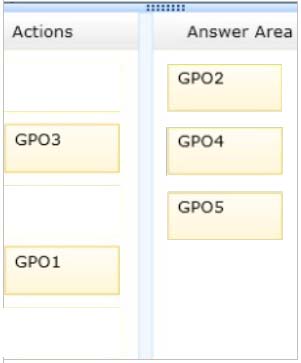
Box 1: GPO2 -
Box 2: GPO4 -
Box 3: GPO5 -
Note:
* First at the domain level (GPO2), then at the highest OU level GPO4, and finally at the OU level containing user1 GPO5.
Incorrect:
* Read and Apply group policy are both needed in order for the user or computer to receive and process the policy
Not GPO1: Group1 has Deny Apply Group Policy permissions on GPO1.
Not GPO3: Group1 has Deny Read permissions on GPO3.
GPO2 and GPO4 are disabled.
* When a Group Policy Object (GPO) is enforced it means the settings in the Group Policy Object on an Organization Unit (which is shown as a folder within the
Active Directory Users and Computers MMC) cannot be overruled by a Group Policy Object (GPO) which is link enabled on an Organizational Unit below the
Organizational Unit with the enforced Group Policy Object (GPO).
* Group Policy settings are processed in the following order:
1 Local Group Policy object
2 Site.
3 Domain
4 Organizational units
GPOs that are linked to the organizational unit that is highest in the Active Directory hierarchy are processed first, then GPOs that are linked to its child organizational unit, and so on. Finally, the GPOs that are linked to the organizational unit that contains the user or computer are processed.

Box 1: GPO2 -
Box 2: GPO4 -
Box 3: GPO5 -
Note:
* First at the domain level (GPO2), then at the highest OU level GPO4, and finally at the OU level containing user1 GPO5.
Incorrect:
* Read and Apply group policy are both needed in order for the user or computer to receive and process the policy
Not GPO1: Group1 has Deny Apply Group Policy permissions on GPO1.
Not GPO3: Group1 has Deny Read permissions on GPO3.
GPO2 and GPO4 are disabled.
* When a Group Policy Object (GPO) is enforced it means the settings in the Group Policy Object on an Organization Unit (which is shown as a folder within the
Active Directory Users and Computers MMC) cannot be overruled by a Group Policy Object (GPO) which is link enabled on an Organizational Unit below the
Organizational Unit with the enforced Group Policy Object (GPO).
* Group Policy settings are processed in the following order:
1 Local Group Policy object
2 Site.
3 Domain
4 Organizational units
GPOs that are linked to the organizational unit that is highest in the Active Directory hierarchy are processed first, then GPOs that are linked to its child organizational unit, and so on. Finally, the GPOs that are linked to the organizational unit that contains the user or computer are processed.
send
light_mode
delete
All Pages

